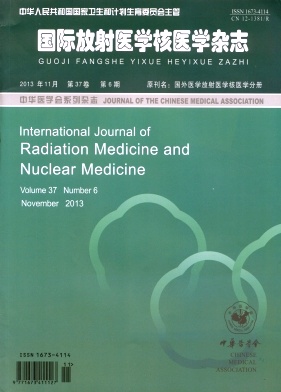-
噬菌体展示技术是一项将外源的重组肽、蛋白质包括抗体片段融合到噬菌体颗粒衣壳蛋白上, 用于筛选功能性多肽或蛋白片段的生物技术。Smith将外源基因插入丝状噬菌体f1的P3基因, 获得的重组噬菌体可在体外稳定增生, 使目的基因编码的多肽以融合蛋白的形式展示在噬菌体表面, 从而创立了噬菌体展示技术[1]。此方法可在受体分子尚不清楚的情况下, 利用多肽片段特异性与噬菌体表面蛋白结合的特点, 寻找特异性结合的靶标分子, 确定其结合部位和结构域[2-3]。噬菌体展示技术能大大缩短研究周期, 而且筛选过程可以与治疗在相同条件下进行, 避免了体外筛选得到的多肽片段在体内实验无效或活性低的缺点, 保证了筛选到的短肽的靶向特异性。
利用噬菌体展示技术筛选的多肽和抗体由于分子小、穿透力强、亲和力和特异性高等特点, 适用于肿瘤三维成像和分子影像学诊断, 可以用于肿瘤的免疫放射治疗及其定位诊断、疗效评价和制定后续治疗方案。
HTML
-
噬菌体展示筛选得到的多肽通过放射性核素标记, 能够进行分子成像, 特别是与双功能或多功能螯合物结合的放射性多肽, 在肿瘤模型的成像中取得了很好的实验结果。
-
99Tcm是核医学临床诊断中应用最广的医用核素。99Tcm标记的用于诊断脏器疾病和功能的放射性显像剂是在99Mo-99Tcm发生器中用生理盐水淋洗得到的99TcmO4-。但多数情况下是用还原剂还原成+1、+3、+4和+5价离子后再与含O、N、S、P等供体原子的化合物反应制成放射性显像剂。99Tcm标记的放射性显像剂不仅可用于状态图像诊断, 还可用于功能(如脑、心肌、肝功能等)诊断, 其约已占诊断用放射性显像剂的85%, 可用于诊断脑、心肌肿瘤等疾病和几乎所有的脏器疾病[4-6]。
Chen等[7]经过对多肽TAG-72三轮的筛选和使用两种不同的洗脱条件筛选, 得到了序列GGVSCMQTSPVCENNL和NPGTCKDKWEICLLNGG。体外的实验证实这两种肽是稳定的, 经99Tcm标记的这两种多肽在患LS-174T(大肠癌细胞)肿瘤的小鼠中的分布是一致的, 但90 min后, 99Tcm-DPRHCQKRVLPCPAW在瘤中的积累比另外两种99Tcm标记的多肽高出近3倍[8]。SPECT/CT图像上的分布与生物学分布结果是一致的。
Hui等[9]筛选得到的多肽CGNSNPKSC(GX1)能特异性地结合到血管内皮, 99Tcm标记的GX1能特异地与小鼠脐静脉内皮细胞和人脐静脉内皮细胞结合。SPECT显示, GX1可以有效地针对小鼠模型, 具有较高的肿瘤靶向性。体内的生物学分布结果显示, 24 h肿瘤放射性摄取为(0.74±0.02)%ID/g, 比肌肉摄取量高11倍。GX1可用于检测肿瘤新生血管, 提高靶向肿瘤血管生成成像水平。兰晓莉等[10]用99Tcm标记筛选多肽ATWLPPR, 在荷人乳腺癌裸鼠模型实验结果中发现, 以双功能联结剂联肼尼克酰胺作为双功能螯合剂, 标志物体外稳定, 主要由肝脏和肾脏排泄, 肿瘤组织可以对该显像剂特异性摄取, 提示该显像剂可以用于肿瘤诊断。
-
111In是一种标记肽广泛使用的放射性核素, 可用于SPECT诊断, 它的半衰期为2.8 d, 可发射能量为173 keV和247 keV的γ射线[11-13]。
多肽ANTPCGPYTHDCPVKP目前已被用于体内肿瘤的显像[14-15]。线性肽ANTPCGPYTHDCPVKP与Galectin-3对转铁蛋白半乳糖凝集素3的抑制率是50%, 它能够定位于肿瘤血管内皮细胞。111In-1, 4, 7, 10-四氮杂环十二烷-1, 4, 7, 10-四乙酸(1, 4, 7, 10-tetraazacyclododecane-1, 4, 7, 10-tetraacetic acid, DOTA)ANTPCGPYTHDCPVKP PET显像研究显示, 肽在荷瘤小鼠体内肾脏处的摄取较高, SPECT/CT的研究显示, 111In-DOTA-glysergly(GSG)ANTPCGPYTHDCPVKP在荷瘤小鼠体内有良好的肿瘤摄取和对比度。
-
随着PET[16]检查设备的普及, 许多研究者开始研究使用一些发射正电子的放射性核素(如18F、125I、64Cu等)对多肽进行标记, 进而用于肿瘤组织受体显像, 以期达到诊断早期肿瘤的目的。Champion等[17]对18F标记的多肽AH11158进行分布和显像观察, 结果发现, 18F-AH11158主要经由肾脏排泄(37%), 其次是肝脏(15%)以及小肠、大肠上段和下段(11%); PET显像研究与分布研究结果一致。Picchio等[18]采用放射自显影的方法研究了18F-1-α-D-[5'-脱氧-5'-氟阿拉伯呋喃糖基]-2-硝基咪唑, 结果发现肿瘤乏氧与肿瘤新生血管生成并不相关, 为乏氧肿瘤的治疗提出了一个新的理念。利用噬菌体多肽展示技术获得的一种靶向鼻咽癌多肽EDIKPKTSLAFR, 以131I标记后, 检测噬菌体颗粒在鼻咽癌荷瘤小鼠体内的稳定性和组织分布, 结果表明其只在鼻咽癌肿瘤中富集, 可作为诊断鼻咽癌肿瘤的工具[19]。
Zitzmann等[20]利用噬菌体展示技术筛选前列腺特异性膜抗原阴性的细胞株DU-145, 分离得到DUP-1多肽片段, 利用131I标记该多肽片段, 体外实验显示其标记率和放化纯度较高, 将该标记多肽静脉注射入荷人前列腺癌裸鼠动物模型中, 显示该多肽能够聚集于裸鼠的肿瘤组织, 其放射性强度是正常对照组的3倍。
1.1. 99Tcm标记筛选多肽的显像
1.2. 111In标记筛选多肽的显像与示踪
1.3. 其他核素标记筛选多肽的显像与示踪
-
Anthony等[21]利用111In标记的奥曲肽治疗生长抑素受体阳性肿瘤, 显示出很好的疗效, 使进展期肿瘤处于稳定状态, 但是对于晚期肿瘤无法起到好的抑瘤效果。该治疗的不良反应多为轻度骨髓抑制, 对肾功能没有明显的损害。111In还能发射俄歇电子, 其射程与DNA双螺旋直径相当, 在核内能起到杀灭肿瘤细胞的作用。
-
90Y发射的β射线最高能量为2.27 MeV, 组织内最大射程为10 mm, 适于作为治疗核素。90Y通过DOTA鳌合物与多肽相连, 标记物不进入细胞内也能对细胞产生杀伤作用, 起到治疗效果。Mitra等[22]分别用3.7×106 MBq和9.25×106 MBq 90Y标记的RGD4C对荷DU145人前列腺癌裸鼠模型进行治疗, 治疗3周后, 抑瘤率分别达到70%和63%, 且免疫组化结果显示, 肿瘤组织中凋亡细胞的数量明显增多, 而其他器官未见急性放射性损伤。
Reubi等[23]研究表明, 标记多肽90Y-DOTA-Tyr3-octreotide对SSTR2和SSTR5(2种生长抑素受体亚型)均具有高亲和力, 因此特别适用于那些受体亚型高表达的肿瘤。使用该标记多肽进行的I期临床试验结果显示:使用90Y-DOTA-Tyr3-octreotide的患者两个疗程累计的剂量为7.421 GBq, 未发现严重的应激反应, 约27%的患者的肿瘤组织部分缩小或消失[24]。
-
多肽EDYELMDLLAYL(FROP-1)是经过多轮筛选在噬菌体十二肽库中筛选得到的, 它能够特异性结合多种肿瘤细胞, 能与乳腺癌细胞特异性结合并随孵育时间的增加而增强, 但与脐静脉内皮细胞和永生化角质形成细胞的亲和力较低; 利用131I标记的FROP-1在注射45 min后, 乳腺癌细胞放射性摄取达到3.8%ID/g, 显示该多肽能够用于放射性核素靶向治疗[25]。
2.1. 111In标记的多肽的治疗作用
2.2. 90Y标记的多肽的治疗作用
2.3. 131I标记的多肽的治疗作用
-
噬菌体展示技术正逐步发展成熟, 为获取对癌症诊断和治疗有价值的多肽或抗体提供了重要手段。用不同的放射性核素对多肽进行标记的方法也基本成熟, 针对肿瘤细胞不同表达分子的特异性结合多肽, 为肿瘤治疗提供了新的靶点, 也为放射标记的肿瘤检测、化疗药物的给药、药物敏感试验及肿瘤的免疫治疗提供了新的分子靶位。目前的研究结果显示经过放射性核素标记的多肽的活性变化较小, 将该项技术运用到临床治疗中已经显示了部分效果, 但是目前正电子核素的价格昂贵, 阻碍了核素标记多肽的广泛应用。多肽可以标记多种药物, 使药物能够起到靶向给药的作用, 提高药效降低机体应激反应。总之, 利用噬菌体展示技术筛选得到的多肽在今后的临床诊断和治疗中具有广阔的应用前景。








 DownLoad:
DownLoad: